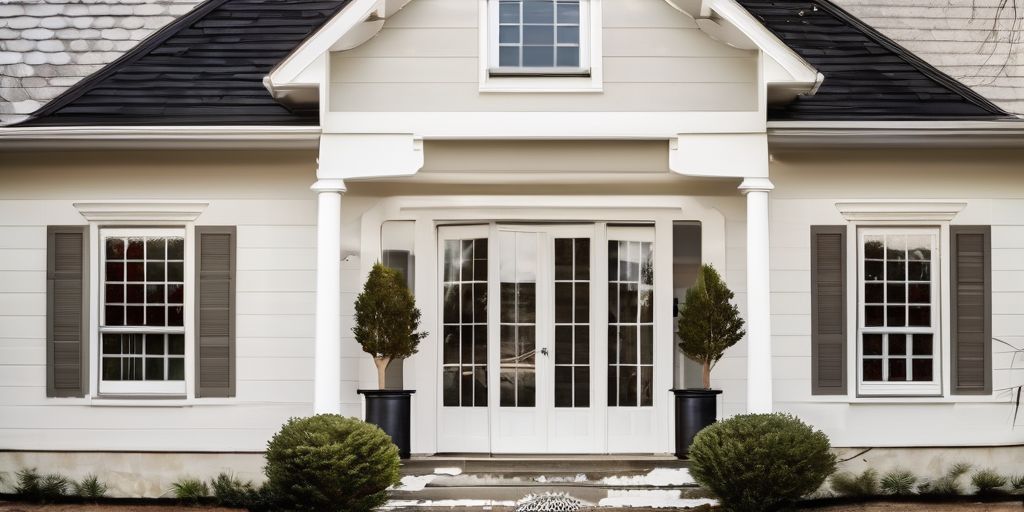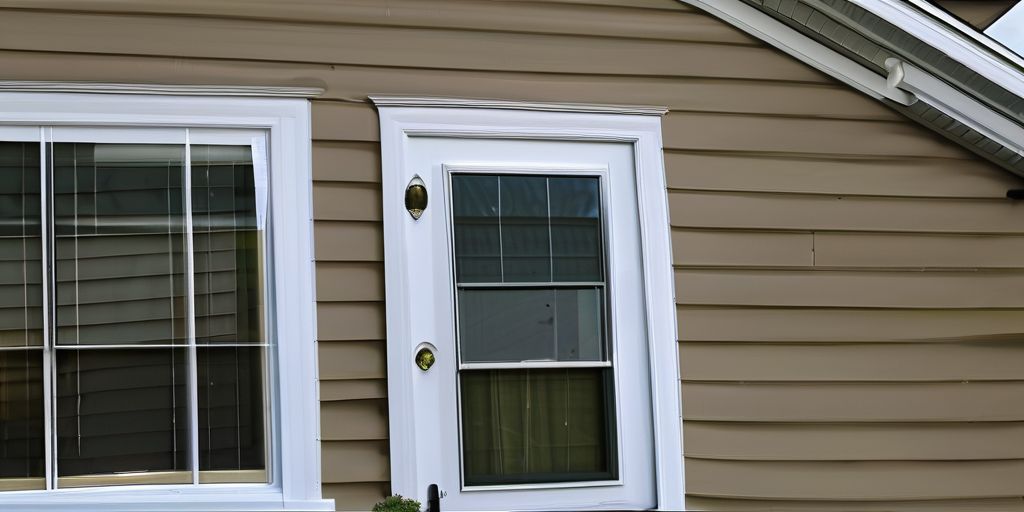Vinyl siding painting in blue-grey is a transformative way to enhance the exterior of your home in Kitchener-Waterloo. Whether you’re looking to refresh the look of your property or add value to your home, mastering the art of vinyl siding painting is essential. In this article, we will explore the techniques and considerations for achieving a flawless finish with blue-grey vinyl siding paint.
Key Takeaways
- Assess the condition of your vinyl siding and choose the right time of year in Kitchener-Waterloo for repainting to ensure optimal results.
- Select high-quality paint and materials specifically designed for use on vinyl siding to prevent peeling and fading over time.
- Prepare your workstation carefully, with attention to safety and efficiency, and protect surrounding areas to avoid paint spills and splatters.
- Use the right brushes and rollers to apply multiple coats evenly and ensure proper drying time for a smooth, long-lasting finish.
- Consider Kitchener-Waterloo’s climate when planning your project, avoiding extreme temperatures and moisture for the best results.
Assessing the Condition of Your Vinyl Siding
Before you start repainting, it’s crucial to evaluate the state of your vinyl siding. This ensures that the new paint adheres well and lasts longer. Here’s how to go about it:
Identifying Damage and Wear
- Inspect for warping and buckling: These issues can compromise the siding’s integrity and affect the paint job.
- Look for cracking and splitting: These are common problems that need to be addressed before painting.
- Check for fading and discoloration: Consistent color fading indicates the need for a fresh coat of paint.
- Examine for moisture damage: This can lead to mold, mildew, or algae growth, which requires special attention.
- Ensure there are no loose or missing panels: Secure or replace any damaged sections.
Cleaning and Prepping the Surface
- Regular cleaning: Use a soft cloth or brush and a suitable cleaning solution to remove dirt and mildew.
- Avoid harsh chemicals: Steer clear of abrasive cleaners and solvents that can damage the siding’s surface.
- Test for brittleness: Clean a small area to check if the siding is still sturdy. If it’s brittle, it may need replacing.
Choosing the Right Primer
- Select a primer designed for vinyl siding: This ensures better adhesion and durability of the paint.
- Consider the climate: Choose a primer that can withstand Kitchener-Waterloo’s weather conditions.
- Apply the primer evenly: This helps in achieving a smooth and long-lasting finish.
A thorough assessment and proper preparation can make a significant difference in the longevity and appearance of your painted vinyl siding.
Selecting the Best Paint for Vinyl Siding
Understanding Paint Formulations
Choosing the right paint formulation is essential for a long-lasting finish on vinyl siding. Acrylic paints are often recommended due to their flexibility and durability. They can expand and contract with the siding without cracking. High-quality paints with urethane and acrylic resins are known for their longevity and fade resistance. Additionally, a paint with a light reflectance value (LRV) higher than the original siding color can help prevent heat build-up, which is especially important in sunny areas.
Choosing the Right Color
Selecting the perfect shade of blue for your vinyl siding is a crucial step in transforming your home’s exterior. Consider the architectural style of your home and the surrounding landscape to ensure a harmonious blend. It’s also important to compare color options to ensure a finished look that complements the existing elements of your home. Remember, the goal is to enhance the home’s appearance while respecting the character of the neighborhood.
Considering Environmental Factors
When planning your repainting project, consider the local climate and seasonal weather patterns to ensure the best possible outcome. The type of paint you choose must be compatible with vinyl siding to ensure proper adhesion and to prevent peeling or warping over time. In Kitchener-Waterloo, where weather can be quite variable, selecting a paint that can withstand different weather conditions is crucial. This includes resistance to UV rays, moisture, and temperature fluctuations.
Preparing Your Workstation for Painting
Gathering Necessary Tools and Materials
Before starting your painting project, it’s crucial to gather all the necessary tools and materials. Proper organization can significantly streamline the painting process. Start by creating a checklist to ensure nothing is overlooked. Here’s a basic list to get you started:
- Paint brushes or rollers suitable for exterior surfaces
- Drop cloths to protect the ground and landscaping
- Painter’s tape for clean edges
- Ladder or scaffolding for reaching higher areas
Thorough preparation and the right materials are the foundation of a successful paint job.
Setting Up a Safe and Efficient Workspace
Preparation is the cornerstone of any successful project. Here are some steps to ensure your workspace is safe and efficient:
- Site Assessment: Conduct a thorough inspection of the site to identify special requirements or challenges.
- Surface Preparation: Clean, sand, and prime surfaces for optimal paint adherence and durability.
- Protective Measures: Carefully mask and cover areas not to be painted to ensure neat, precise work.
- Equipment Preparation: Set up and calibrate spray painting equipment specific to the paint and surface types.
Remember, thorough preparation and the right materials are the foundation of a successful paint job.
Protecting Surrounding Areas
To ensure a neat and professional finish, it’s essential to protect the surrounding areas. Here are some tips:
- Ventilation: Ensure proper ventilation to manage paint fumes and maintain air quality during both application and curing.
- Masking and Covering: Meticulously protect furniture, floors, and non-painted areas to prevent overspray.
- Equipment Selection: Use appropriate sprayers for exterior spaces to ensure a fine finish and minimize overspray.
While the focus is on the technical aspects of painting, it’s worth noting that the vibrant colors of a freshly painted home can complement the natural beauty of Kitchener’s parks and green spaces, such as Victoria Park or the Walter Bean Grand River Trail.
Techniques for Even Paint Application
Achieving a smooth and even paint application on vinyl siding requires careful attention to detail and the right techniques. Here are some essential tips to ensure a professional-looking finish:
Using the Right Brushes and Rollers
- Start with a high-quality brush or roller designed for exterior surfaces.
- Rollers should have a medium nap to hold enough paint without causing drips.
- For hard-to-reach areas, consider using a sprayer for a smooth, consistent coverage.
Applying Multiple Coats
- Apply paint in thin, even layers, allowing sufficient drying time between coats.
- Two thin coats are better than one thick coat to avoid drips and ensure even coverage.
- Maintain a wet edge by painting in sections and blending the edges together while the paint is still wet.
Ensuring Proper Drying Time
- Allow each coat to dry thoroughly before applying the next one.
- Check the paint manufacturer’s recommendations for drying times.
- Proper drying time helps prevent issues like peeling and uneven color.
Pro Tip: For the best results, apply primer before painting. This helps the paint adhere better and results in a more even color.
By following these techniques, you can achieve a durable and attractive finish on your vinyl siding, maximizing the efficiency and quality of your exterior paint job.
Choosing the Optimal Time for Repainting
Selecting the best time to repaint your vinyl siding in Kitchener-Waterloo is essential for achieving a durable and attractive finish. The local climate plays a significant role in determining the right time for this task. Here are some key considerations:
Understanding Kitchener-Waterloo’s Climate
Kitchener-Waterloo experiences a range of weather conditions throughout the year. Spring and summer are the best times to paint your home’s exterior. Warm weather is good for dry time, but ensure it’s not too hot or humid for the paint to adhere properly. Avoid painting during extreme temperatures, as both heat and cold can negatively impact the drying process and the final finish.
Timing Your Project for Best Results
To achieve the best results, plan your painting project between late spring and early fall. This period typically offers mild weather with lower chances of rain, which is ideal for painting. Here are some tips to help you time your project:
- Check the weather forecast to avoid rainy days.
- Aim for days with temperatures between 50°F and 85°F.
- Avoid painting in direct sunlight to prevent the paint from drying too quickly.
Avoiding Common Weather-Related Pitfalls
Weather-related issues can significantly affect your painting project. Here are some common pitfalls to avoid:
- High humidity can cause the paint to take longer to dry and may result in a poor finish.
- Painting in direct sunlight can lead to uneven drying and blistering.
- Cold temperatures can prevent the paint from curing properly, leading to peeling and cracking.
While assessing, consider the local climate in Kitchener-Waterloo. The region’s weather can influence the condition of your siding and the best time for repainting. For instance, proximity to landmarks like the Grand River might affect the siding due to increased moisture levels in the air.
Maintaining Your Painted Vinyl Siding
Regular Cleaning and Inspection
To keep your painted vinyl siding looking fresh, regular cleaning and inspection are essential. Use a mild detergent and a soft brush to remove dirt and debris. This not only maintains the appearance but also extends the lifespan of the paint. Painted vinyl siding will last at least 10 years if done properly.
Touch-Up Techniques
Over time, you may notice small areas where the paint has chipped or faded. Address these issues promptly to prevent further damage. Clean the area thoroughly, allow it to dry, and then apply a matching paint. This will help maintain a uniform look across your siding.
Long-Term Care Tips
- Inspect Annually: Check for any signs of wear or damage at least once a year.
- Clean Regularly: A gentle wash every six months can prevent dirt buildup and mildew.
- Avoid Harsh Chemicals: Use mild cleaning solutions to avoid damaging the paint.
- Repaint When Necessary: Apply fresh paint every 10 years to keep your vinyl siding looking new.
Remember, the goal is to enhance the home’s appearance while respecting the character of the neighborhood.
By following these tips, you can ensure your painted vinyl siding remains in excellent condition for years to come.
Maintaining your painted vinyl siding is essential for preserving your home’s curb appeal and longevity. Regular cleaning and touch-ups can keep your siding looking fresh and vibrant for years. For expert advice and professional services, visit our website to learn more about our comprehensive exterior painting solutions.
Conclusion
In conclusion, mastering the art of painting vinyl siding in blue in Kitchener-Waterloo is a rewarding endeavor that can transform the appearance of your home. With the right techniques and materials, you can achieve a beautiful and long-lasting finish that enhances the curb appeal and value of your property. Whether you’re a homeowner or a professional painter, taking the time to learn and perfect this skill will undoubtedly yield impressive results. So, roll up your sleeves, grab your paintbrush, and get ready to give your home a stunning new look.
Frequently Asked Questions
What type of paint is best for vinyl siding?
Acrylic latex paint is recommended for vinyl siding as it provides excellent adhesion, flexibility, and resistance to fading.
Do I need to prime vinyl siding before painting?
Yes, using a primer specifically designed for vinyl siding is essential to ensure proper paint adhesion and a long-lasting finish.
Can I paint vinyl siding in any weather?
It’s best to paint vinyl siding in mild weather conditions, ideally between late spring and early fall in Kitchener-Waterloo, to avoid extreme temperatures and rain.
How many coats of paint are needed for vinyl siding?
Typically, two coats of paint are recommended for even coverage and durability. Make sure to allow proper drying time between coats.
How do I maintain painted vinyl siding?
Regular cleaning with a mild detergent and water, along with periodic inspections for damage or wear, will help maintain the appearance and longevity of painted vinyl siding.
What should I do if the paint starts to peel or fade?
If you notice peeling or fading, it’s important to address the issue promptly by cleaning the area, applying a primer, and repainting with high-quality acrylic latex paint.




